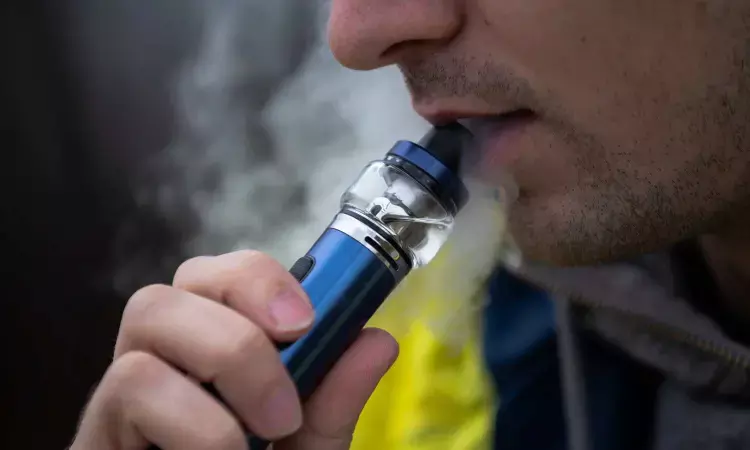- Home
- Medical news & Guidelines
- Anesthesiology
- Cardiology and CTVS
- Critical Care
- Dentistry
- Dermatology
- Diabetes and Endocrinology
- ENT
- Gastroenterology
- Medicine
- Nephrology
- Neurology
- Obstretics-Gynaecology
- Oncology
- Ophthalmology
- Orthopaedics
- Pediatrics-Neonatology
- Psychiatry
- Pulmonology
- Radiology
- Surgery
- Urology
- Laboratory Medicine
- Diet
- Nursing
- Paramedical
- Physiotherapy
- Health news
- Fact Check
- Bone Health Fact Check
- Brain Health Fact Check
- Cancer Related Fact Check
- Child Care Fact Check
- Dental and oral health fact check
- Diabetes and metabolic health fact check
- Diet and Nutrition Fact Check
- Eye and ENT Care Fact Check
- Fitness fact check
- Gut health fact check
- Heart health fact check
- Kidney health fact check
- Medical education fact check
- Men's health fact check
- Respiratory fact check
- Skin and hair care fact check
- Vaccine and Immunization fact check
- Women's health fact check
- AYUSH
- State News
- Andaman and Nicobar Islands
- Andhra Pradesh
- Arunachal Pradesh
- Assam
- Bihar
- Chandigarh
- Chattisgarh
- Dadra and Nagar Haveli
- Daman and Diu
- Delhi
- Goa
- Gujarat
- Haryana
- Himachal Pradesh
- Jammu & Kashmir
- Jharkhand
- Karnataka
- Kerala
- Ladakh
- Lakshadweep
- Madhya Pradesh
- Maharashtra
- Manipur
- Meghalaya
- Mizoram
- Nagaland
- Odisha
- Puducherry
- Punjab
- Rajasthan
- Sikkim
- Tamil Nadu
- Telangana
- Tripura
- Uttar Pradesh
- Uttrakhand
- West Bengal
- Medical Education
- Industry
Nicotine absorption lower in children exposed to secondhand vapor compared to second hand smoke: JAMA

A new study published in the Journal of American Medical Association suggests that vaping inside instead of smoking may significantly lower the secondhand exposure to nicotine and other harmful compounds in children, despite both smoke and vapor increase absorption compared to no exposure. Children absorb far more nicotine from secondhand smoke than from secondhand vapor.
Over the last several decades, children's exposure to secondhand tobacco smoke has drastically dropped in many countries, notably in the US and England. Thus, there was a fall in parental cigarette smoking and an increasing number of the individuals who still smoke but not inside. There is another possible source of secondhand exposure to harmful compounds in indoor air due to the widespread use of nicotine e-cigarettes during the 2010s. Therefore, Harry Tattan-Birch and team wanted to evaluate the differences in nicotine absorption between children who are exposed to either secondhand tobacco smoke or secondhand vapor compared to those who are exposed to neither.
This study drew data from a nationally representative sample of US homes from the period of 2017 to 2020. The children who were of 3 to 11 years old with serum levels of cotinine below 15 μg/L were included in this study. The participants were questioned at home before visiting a mobile examination facility a few days later to give biological specimens and the final analysis was carried out on January 9, 2024. The exposure to secondhand smoke or vapor inside within the last seven days were assessed. The covariates included gender, age, household income, ethnicity, weight, and height. The main outcome was serum cotinine levels, which is an objective index of nicotine absorption.
They key findings of this study were:
The average (SD) age of the total 1777 children questioned was 7.4 (2.6) years, with 882 (49.6%) being female and 531 (29.9%) having household incomes below the poverty line.
The nicotine absorption measured by blood cotinine levels was highest among children exposed exclusively to secondhand smoke, followed by those who were subjected only to secondhand vapor, resulting in 83.6% decreased nicotine absorption.
Children with no documented secondhand exposure had a geometric mean cotinine level of 0.016 μg/L, which was 96.7% lower than those who were exposed to secondhand smoking. Overall, switching from smoking to vaping indoors can significantly reduce the children's secondhand exposure to nicotine and other toxic compounds, but not eliminate it completely.
Reference:
Tattan-Birch, H., Brown, J., Jackson, S. E., Jarvis, M. J., & Shahab, L. (2024). Secondhand Nicotine Absorption From E-Cigarette Vapor vs Tobacco Smoke in Children. In JAMA Network Open (Vol. 7, Issue 7, p. e2421246). American Medical Association (AMA). https://doi.org/10.1001/jamanetworkopen.2024.21246
Neuroscience Masters graduate
Jacinthlyn Sylvia, a Neuroscience Master's graduate from Chennai has worked extensively in deciphering the neurobiology of cognition and motor control in aging. She also has spread-out exposure to Neurosurgery from her Bachelor’s. She is currently involved in active Neuro-Oncology research. She is an upcoming neuroscientist with a fiery passion for writing. Her news cover at Medical Dialogues feature recent discoveries and updates from the healthcare and biomedical research fields. She can be reached at editorial@medicaldialogues.in
Dr Kamal Kant Kohli-MBBS, DTCD- a chest specialist with more than 30 years of practice and a flair for writing clinical articles, Dr Kamal Kant Kohli joined Medical Dialogues as a Chief Editor of Medical News. Besides writing articles, as an editor, he proofreads and verifies all the medical content published on Medical Dialogues including those coming from journals, studies,medical conferences,guidelines etc. Email: drkohli@medicaldialogues.in. Contact no. 011-43720751


